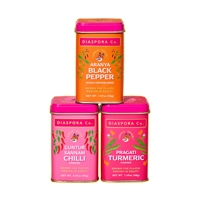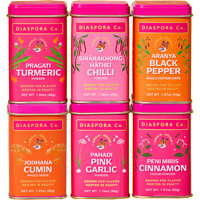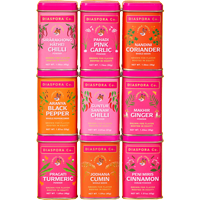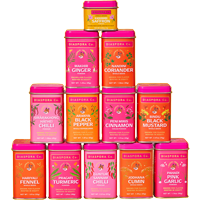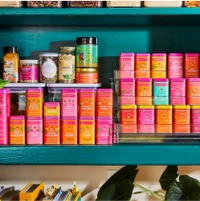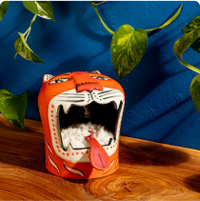In her 1974 treatise on Indian cuisine, cookbook author extraordinaire Madhur Jaffrey pressed her readers to ditch their bottle of curry powder. If “curry” is often an oversimplification of a diverse cuisine, then “‘curry powder’ attempts to oversimplify (and destroy) the cuisine itself,” she argued. For Jaffrey, the industrialized unspecificity of curry powder allows the richness of South Asian cuisines to be standardized, homogenized, and ultimately extirpated.
But curry powder is a sticky thing: Even as Jaffrey decries it, she also shares recipes calling for it in her books, including in Madras Curried Tomato Soup, an Anglo-Indian tomato soup dish based in part on pre-packaged Madras curry powder. While she marks this as a “‘Raj’ period soup,” thus differentiated from an “authentic” Indian dish, her use of Madras curry powder highlights the staying power of this particular spice blend, in spite of its relationship to colonialism.
Today, we are still embroiled in this same debate. Every so often, articles (sometimes in response to baseless claims alleging Indian food is entirely based on one spice) crop up claiming that curry powders are a “total lie” or “merely a figment of the British colonial imagination.” And yet, curry powders are still sold worldwide and are often invoked in novel ways.
What does it mean to call an extant spice blend a figment of imagination? What is the connection of Madras curry powder to its titular home, both historically and today? Blended in each spoonful of Madras curry powder is a larger story of the violence of colonialism, as well as the ways cooks have transformed the homogenized blend into something innovative and exciting.
![]()
Curry — what food writer Chitrita Banerji calls that “slippery eel of a word” in her book Eating India — emerged in part out of the broader imperial project. Many historians, such as Lizzie Collingham, argue that the British learned the word curry from the Portuguese, who in turn learned it from a handful of South Indian languages. Some scholars point to the similarity between curry and the words kari in Tamil and karil in Kannada and Malayalam, which were at that point in time used to refer to seasoning spices, though others have proposed alternate etymologies.
Whatever the origin of curry is, its powdered form came soon after. Curry powder is listed as an ingredient in dishes found in English manuscript cookbooks dating back to the 1700s. But industrial curry powder as we know it today skyrocketed in popularity in a particular 19th-century moment.
After the 1857 Sepoy Rebellion, in which Indian soldiers throughout the subcontinent rose up against the East India Company, British imperialists panicked. Imperial attitudes towards Indian people, history, and cuisine became more clearly about the assertion of British superiority, and replete with increased explicit racism. As part of this augmented social stratification, curry powder worked to homogenize and dumb down Indian food. Food sociologist Krishnendu Ray told me that it was a “very English way of taming an unruly, unknown manner of Indian eating.”
Blended in each spoonful of Madras curry powder is a larger story of the violence of colonialism, as well as the ways cooks have transformed the homogenized blend into something innovative and exciting.
It was at this fraught moment that industrialized, pre-packaged curry powder rose in popularity. At first, there were many different types of curry powder. One English cookbook from that period lists recipes for Delhi, Madras, and Bengal curry powders, all giving instructions to make spice blends laden with turmeric, chili, and/or cayenne pepper. Their differences were at times minimal, arbitrary, and idiosyncratic: a Madras curry powder might contain slightly more cayenne pepper (though, in some instances, slightly less) or call for fenugreek, saffron, or cinnamon, whereas a Bengal curry powder might not. Whatever the recipe, one 19th-century writer noted in a recipe for Madras curry powder that the blend “may be added to any stew of meat, poultry, or game.” Curry powder also featured prominently in mulligatawny soup, a dish that Salman Rushdie has chastised for “tr[ying] to taste Indian, but end[ing] up being ultra-parochially British, only with too much pepper.”
Madras curry powder as a blend ultimately grew to be more iconic than other regional curry blends. Part of the reason why may lie in the unique connection between Madras and British imperialism. Madras (or modern-day Chennai) acted as one of the main ports for goods moving from the Indian subcontinent and its proximate regions to Europe. Madras was also home to one of the earliest English trading posts on the subcontinent, lending itself to a long relationship with English imperialists. Imperial agents returning home may have employed Madras curry powder as a means to satiate a broader nostalgia for their time in India.
Further, Madras curry powder was often promoted as “spicier” than the alternatives of Bengal and Bombay. Consuming spicy foods, as scholars like Elizabeth Buettner have shown, was an important way for white British men to perform masculinity and claim a sense of swagger. In William Thackeray’s social satire novel Vanity Fair, returned imperialist buffoon Jos Sedley attempts to demonstrate his modishness by “gobbling” down a curry so hot it makes other guests cry out for water. Madras curry powder, known for its spiciness, may have sharpened such performances.
![]()
The nostalgia that curry powder embodied for the British was neither neutral nor benign. Rather, such nostalgia allowed British imperialists to explicitly domesticate the broader empire. Literary scholar Susan Zlotnick has argued that Victorian women cooked curry in order to “neutralize the threat of the Other by naturalizing the products of foreign lands.” Madras curry powder, in particular, is emblematic of this domestication of empire: By consuming a spice blend with a specific Indian locale in its title, Victorian eaters quite literally pulled Madras into the sphere of “Greater Britain” — an ideological concept used to further colonialism.
In part because of this role as a tool of imperialism, Madras curry powder quickly took off in the British Isles. Curry powder became a popular topic of discussion in women’s magazines in the 19th century. One reader, quoted in historian Lizzie Collingham’s book Curry, alleged she had “learned the secret for preparing ‘Genuine Madras Curry Powder’ from the butler to one of the sons of the infamous Tipoo Sahib,” referring to the ruler of Mysore, Tipu Sultan, who fought in wars against the British. Soon, advertisements began proliferating pedaling ‘Genuine Madras Curry Powder’ and claiming it was the only way to make a “real Indian curry.” These discourses of authenticity, bolstered by the powder’s understood connection to Madras, allowed white British eaters to commandeer and claim ownership over Indian cuisine.
But if Madras curry powder in the colonial era represented a nostalgia for time spent in India as part of the imperial project, the spice blend in the postcolonial era transformed to embody the nostalgia for a fallen empire. In the 1960s and 1970s, recipes calling for Madras curry powder in the British media became more quotidian. Eating Madras curries in restaurants also became increasingly popular.
Scholar Elizabeth Buettner has detailed how the white British consumption of curry-powder-laced dishes in Raj-style Indian restaurants became an arena for “ridicule, critique, and displays of racism” as well as a space to lament the fall of empire.
Today, Madras curry powder is often rejected amongst British consumers as inauthentic and culturally vague. Food sociologists like Ray think that we have reached the end of the road of curry powder. “Curry powder has died a total uncool death,” he told me. “No one wants to touch it. […] We have reached the end of curry as a serious cultural construct.”
But with death comes potential rebirth. We are now on the cusp of a new phase of curry powder, which is its reclamation amongst South Asian communities in Euro-America. Hip spice brands helmed by South Asian entrepreneurs are beginning to brand the powder in what Ray calls a “tongue-in-cheek, retro” manner. Such a reclamation, Ray says, allows for greater convenience in cooking while also polishing curry powder with a new sort of cultural capital that rejects hard-and-fast notions of authenticity.
![]()
Madras curry powder, of course, is not only used on the British Isles. Rather, it is now sprinkled into dishes throughout the world. Despite Jaffrey’s claims that “no Indian ever uses curry powder in his own cooking,” curry powder can and does exist on the subcontinent. It is make-believe that every Indian cook grinds their own spices. This class-based fantasy, one excellent blog post on the subject points out, is proved wrong simply by “walking into any Indian grocery store — in India or the diaspora — and seeing the vast variety of packaged pre-ground spices and spice mixes on offer.” The author describes curry powder as “one of those commercial spice mixes that is now as Indian as curry or Indian English.”
The nostalgia that curry powder embodied for the British was neither neutral nor benign. Rather, such nostalgia allowed British imperialists to explicitly domesticate the broader empire.
Critically, Madras curry powder has a life of its own in former British colonies. Curry powder was likely brought to the Caribbean with Indian indentured laborers as an easy means to garner a taste of home. But now, in places like Guyana, curry has become a national dish. This national dish often utilizes Madras curry powder. As food writer Gaitri Pagrach Chandra, who grew up in Guyana, notes, “Madras curry powder became the standard spice [in Guyana] because it was thought to be very hot and spicy — though that doesn’t actually stop people from adding fresh chilis to their curries.” In addition to this spiciness, the moniker of Madras connected communities to a sense of home: Ray argues that in Indian diasporic communities, the “Madras” in Madras curry powder can stand in for a whole coastline, subcontinent, or even continent.
Whereas imperial nostalgia led to the standardization of curry powder, diasporic nostalgia has led to larger creativity in usages of curry powder and definitions of Indian cuisine. Pagrach Chandra details how Madras curry powder is employed with the additions of garam masala, fresh chilies, and other spices in Guyanese cooking. Such food, she writes in a book chapter on Indo-Guyanese cooking, “spawned from subsistence cooking, later enriched by hazy memories, limited by the initial paucity of ingredients, symbolizes our entire background and continues to function as a major component of Indo-Guyanese identity.” Curry powder, it seems, has emerged from its homogenized origins to create something playful and locally rooted yet still globally connected.
“Can curry powder ever be saved? Can it ever go home?” asked philosopher Lisa Heldke. It has been almost 50 years since Jaffrey exhorted her readers to put down the curry powder jar, and almost 20 years since Heldke first posed this question. Now, perhaps the important question is not whether Madras curry powder can go home, but rather, where its homes even are. The long history of Madras curry powder and its present-day innovations suggests that it has a different meaning — and a different home — from Georgetown to Jodhpur, from Durban to Devon to Delhi.






